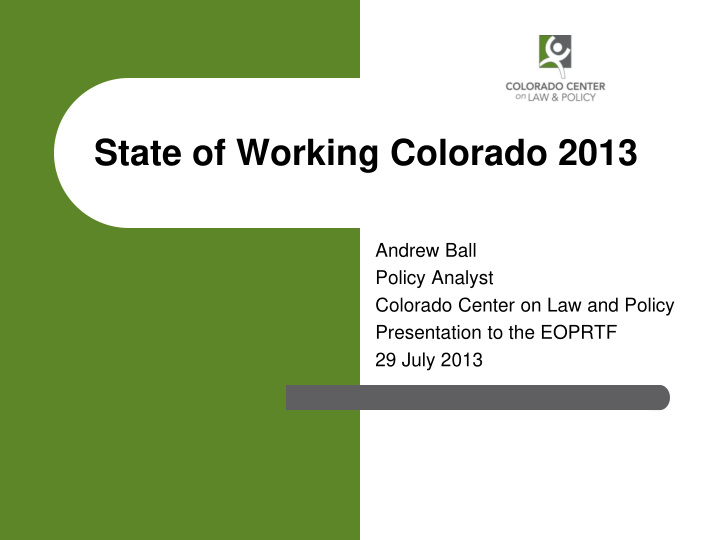



State of Working Colorado 2013 Andrew Ball Policy Analyst Colorado Center on Law and Policy Presentation to the EOPRTF 29 July 2013
Acknowledgement Thanks to the EOPRTF for the opportunity to present our findings and for the opportunity to play a role in developing solutions. The Economic Policy Institute The Colorado Center on Law and Policy Christy Murphy, Tracey Stewart, Terry Scanlon, Elisabeth – Arenales and Michelle Webster
State of Working Colorado 2013 Annual report using data from the American Community Survey, Current Population Survey, Local Area Unemployment Statistics Survey among others. Data are mostly through 2012, although some data are for 2011. All data is most recent available. Full report: http://www.cclponline.org/publication_library/pub/single/1279/st ate-of-working-colorado-2013
CO recovery outperforms nation, does not benefit all Coloradans Overall, economic conditions in Colorado are improving. Many communities in Colorado are still struggling, some have been left behind. Despite Colorado’s relative wealth, inequality is alive and well in Colorado.
Labor market Part I
Broad economic indicators are showing improvement Unemployment rate has steadily • decreased from its high point of nine percent set in late 2010. Colorado unemployment rate • has largely remained below the national rate. The labor force has grown • steadily since last summer. 20,000 more people in labor force than its previous peak, set in April 2009. (Nearly) all of the jobs lost in the • great recession have been regained.
Despite improvement in the labor market, large shortfall remains
Labor force participation rates are a good proxy for labor market conditions
Unemployment rates vary by education, race and age Unemployment rates are • noticeably higher among minorities, the young and less-educated communities. Many unemployment • rates doubled from 2007 to 2012.
Poverty in Colorado Part II
Nearly one in three Coloradans live in or near poverty In 2000, 8.7 percent of the • Colorado population lived in poverty, in 2011 13.5 percent lived in poverty. 15.9 percent of Americans • lived in poverty in 2011. 34.4 percent of Americans • lived below 200 percent of the federal poverty line.
One in five Colorado children live in poverty The child poverty rate in • Colorado was 9.7 percent in 2000. In 2011, nearly one in five Colorado children lived in poverty (17.5 percent). 22.2 percent of American • children lived in poverty in 2011. 44.3 percent of American • children lived below 200 percent of the federal poverty line in 2011.
Poverty is more prevalent among minorities
Nearly one in two households in poverty are single mother households
Income and economic disparity Part III
Income inequality has grown in Colorado
Highest earners had income increase since pre-recession level High-income earners have • had their household incomes increase since the start of the recession. Low-income earners have • had their household incomes decline since the start of the recession.
Wealth accumulates at the top in Colorado
Median income varies dramatically by race In 2011, the median income for • black Coloradans was only 67 percent that of white Coloradans. In 2011, the median income for • Hispanic Coloradans was only 70 percent that of white Coloradans. In 2011, the median income for • American Indians was 57 percent of whites’ income.
Gender pay-gap exists, even for similarly qualified workers Nationally, a woman with a • Bachelor’s degree earns only 60 percent of man with a bachelor’s degree. In Colorado, women make only • 79 percent of men across all occupations. Women who work in a • community and social service occupation make 96 percent of what men in the same field make. Women who work in the legal • profession make only half of what men in the same field make.
Economic conditions vary across the state Colorado poverty and food assistance by county Median household income Percent of Number of • Poverty Individuals in households households varies widely across state: County rate poverty receiving SNAP receiving Douglas County: $101,193 benefits SNAP Costilla County: $25,949 Colorado 13.5% 542,737 8.3% 164,571 Denver County 18.4% 91,575 10.2% 27,193 Colorado: $57,685 Pueblo County 18.6% 23,509 17.3% 10,734 Mesa County 11.3% 13,148 9.2% 5,523 Weld County 14.7% 28,813 8.9% 8,025 Uninsurance rates vary • Boulder County 14.1% 34,536 2.6% 3,072 from county to county: Larimer County 14.2% 35,522 6.8% 8,300 Adams County: 22.5 percent El Paso County 13.1% 64,251 9.2% 21,902 Adams County 16.5% 55,230 10.8% 16,364 Douglas County: 8.3 percent Arapahoe County 12.1% 54,687 7.8% 17,450 Colorado: 16.9 percent Jefferson County 8.8% 38,489 5.5% 11,883 Douglas County 5.0% 10,687 3.1% 3,225
Conclusion We live in wealthy state, with a better than average labor market; BUT, many Coloradans are being left behind in this economic recovery. Poverty and unemployment rates are highest among the less educated, wages for middle- and low- earners have stagnated and women continue to lag behind men. This Task Force has the opportunity and responsibility to address these inequities.
Contact Andrew Ball Policy and Budget Analyst Colorado Center on Law and Policy 303-573-5669 ext. 316 aball@cclponline.org Website: cclponline.org Full report: http://www.cclponline.org/publication_library/pub/single/1279/state- of-working-colorado-2013
Recommend
More recommend